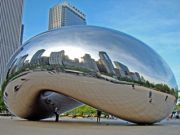Welcome to ‘Stainless Solutions’ from IMOA. Each month, we will cover a different stainless steel issue with tips on design and specification, and links to technical resources. This month we are discussing the family of stainless steels that are most commonly used for architecture - Austenitics. |
| Austenitic Stainless Steels |
|
The austenitic stainless steels have been the primary alloys used for building and construction, consumer products and industrial applications. Their overwhelming popularity is due to several factors:
- Commonly available in all sizes and product forms;
- Highly formable, making very tight crisp bends possible;
- Easy to weld and repair;
- Widest range of aeshetic finishes; and
- Superior impact, blast and seismic performance
|

The Jin Mao, Shanghai, China façade is Type 316 stainless steel and exposed to coastal salt and pollution. Courtesy C. Houska

US coastal private residence with Type 316 stainless steel roof and wall panels. Courtesy C. Houska

Cloud Gate sculpture, Chicago, welded Type 316L stainless steel plate that is exposed to deicing salt. Courtesy C. Houska
|
The most commonly used alloys have been Types 304 and 316 and their low carbon versions Types 304L and 316L. The low carbon versions are only needed when sections 0.125 inches (3.2 mm) thick and greater will be welded. The molybdenum addition to Types 316/316L makes them more resistant to chloride salts (coastal and deicing) and to pollution related corrosion.
Early architectural projects, built some 50 or more years ago, were constructed in Type 302, which is equivalent to modern Type 304. While Types 304/304L and their predecessor Type 302 were widely used historically for building and construction applications, Type 316/316L and sometimes more corrosion-resistant stainless steel alloys are increasingly being specified for exterior and sheltered applications.
This has occurred because of increasing global use of deicing salts, population concentration in coastal areas, and high pollution levels and rain acidity in developing countries. Sheltered areas are even more corrosive because they accumulate the same environmental contaminants but do not benefit from natural rain-washing. Austenitic grades with even greater corrosion resistance are used for industrial and seawater applications.
IMOA’s Stainless Steel Selection System, Case studies, Coastal Salt, Deicing Salt and other website resources provide alloy selection guidance.
Many other brochures are available to provide guidance on different aspects of design and fabrication. They can be downloaded as part of the Stainless Steel Library (zip file, 390 MB) or individually. Some of these are:
|
| Stainless Steel Library |
|
Download a free Stainless Steel Library (zip file, 390 MB) with over 280 pdfs covering building and construction applications, selection, specification, fabrication, sustainability and other common questions. |
| Stainless Solutions e-newsletter archive |
|
For previous issues or to subscibe to the e-newsletter, please visit the archive page. |
| Continuing Education – American Institute of Architects (AIA) |
|
IMOA is an AIA continuing education system approved provider with eight 1-hour programs that are registered for both live face-to-face and distance learning credit.
1. Stainless Steel Sustainable Design
2. Bioclimatic Design With Stainless Steel Weather Screens
3. Stainless Steel Structural Design
4. Stainless Steel Specification For Corrosive Applications
5. Deicing Salt: Stainless Steel Selection to Avoid Corrosion
6. Stainless Steel Finish Specification
7. Advanced Stainless Steel Specification and Problem Avoidance
8. Specification of Stainless Steel Finishes and Grades For Corrosive Applications
For more information or to schedule a workshop contact Catherine Houska, 412-369-0377 or email chouska@tmr-inc.com. |
| What is IMOA? |
|
IMOA (International Molybdenum Association) is a non-profit industry association, which provides technical information to assist with successful specification of molybdenum-containing materials. Molybdenum is an element. When it is added to stainless steel, molybdenum increases its resistance to corrosion caused by deicing salts, coastal atmosphere and pollution.
If you have a topic suggestion for a future issue of Stainless Solutions or need additional technical advice on stainless steel specification and selection, please get in touch here.
Forwarded by a colleague? To receive the next issue of Stainless Solutions automatically, please go to our archive and subscription page. |
| Disclaimer |
|
In providing consultation or other assistance with respect to technical issues, any consultation, assistance or material is provided for the general information of the recipient and should not be used or relied upon for any specific application without first securing competent advice. IMOA and their respective employees, consultants and members (i) make no representation or warranty, express or implied, of any kind with regard to such consultation, assistance or material including no representation or warranty of suitability for any general or specific use; (ii) assume no liability or responsibility of any kind in connection therewith; and (iii) disclaim any and all liability for any claim that arises therefrom. |
|